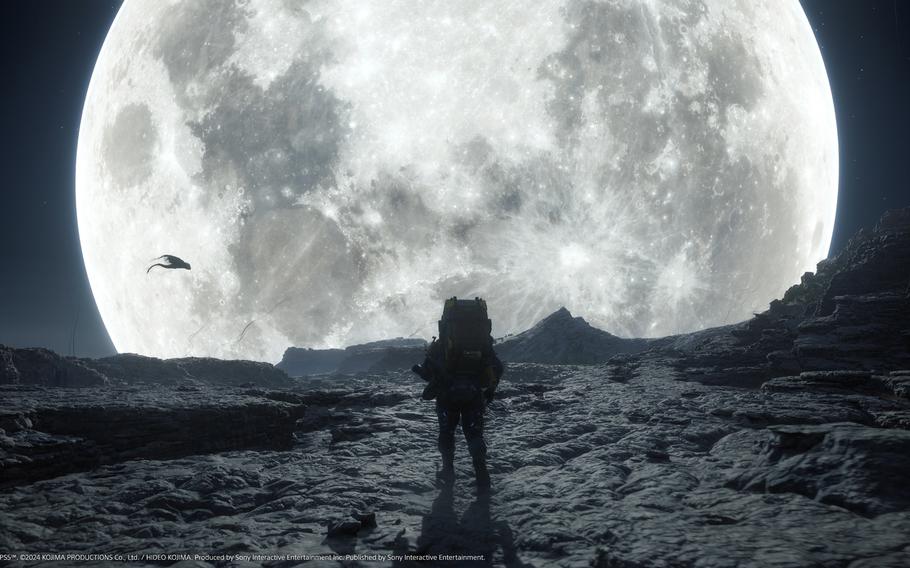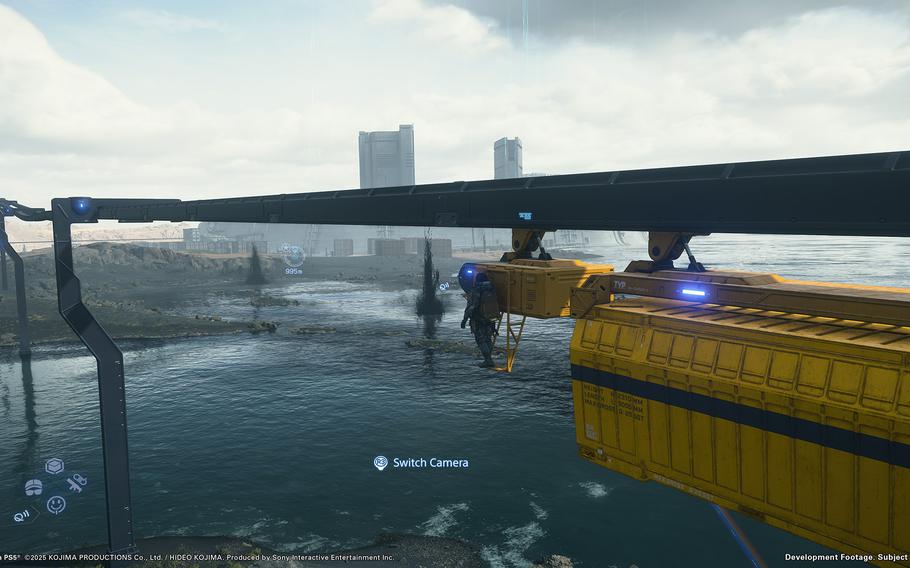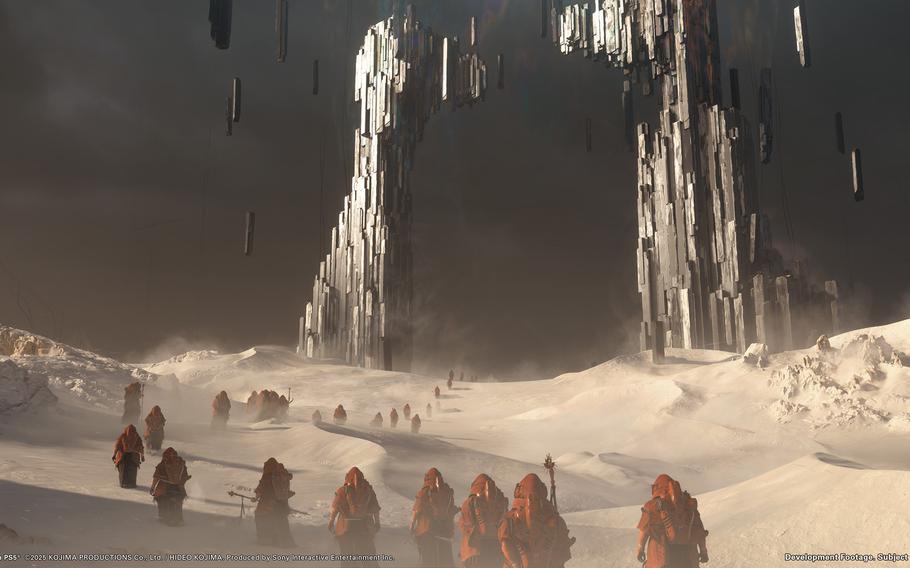
Death Stranding 2: On the Beach is a grand return to storytelling form for director and writer Hideo Kojima, as it is his clearest and best story since 2004’s Metal Gear Solid 3: Snake Eater. (Kojima Productions)
While I’m playing Death Stranding 2: On the Beach, I think about how my best friend Joey put me on to so much of my favorite music throughout my life. The first Death Stranding game was like a video game version of an album by Sigur Rós, the Icelandic post-rock band Joey introduced to me. I’ll never forget how Joey would slide me CDs and say with a knowing smirk, “Trust me, you’ll love this.”
A Hideo Kojima game comes with the promise that the director committed so much of himself to the project. His favorite music, his favorite actors (like returning stars Norman Reedus and Léa Seydoux), and his favorite aesthetics are all over his works. His Metal Gear series, which built his reputation as the world’s most famous game creator, was filled with references and tracks from his favorite groups, from David Bowie to Starsailor.
While I’m playing Death Stranding 2, I realize I am witnessing Kojima and his studio, Kojima Productions, at the peak of their powers, creating blockbuster popular art that challenges its audiences with enigmatic, often inscrutable storytelling. This time, Kojima and longtime co-writers Kenji Yano and Shuyo Murata have written the cleanest, most complete narrative since Metal Gear Solid 3: Snake Eater (2004).
Trailers for the game, personally edited by Kojima, teased a fragmented, absurd story, and there are plenty of such moments. But it all builds together to his most crowd-pleasing finale in 20 years as all the seemingly disordered character and plot elements slide together into a stunning conclusion to the Death Stranding saga. It’s quite a feat, considering the game’s cast includes a cyborg samurai that giggles like an infant and a talking puppet that moves in stop-motion animation (made in the image of Kojima’s beloved German film director Fatih Akin).
Kojima is often criticized for focusing too much on the filmic elements of video games. (Here he has even cast his favorite directors, George Miller and Nicolas Winding Refn, as in-game characters.) That criticism is misinformed and narrow: Kojima’s projects are some of the most systems-heavy, mechanical games in the blockbuster space. DS2 is no different, serving as an expansion and clarification of the 2019 PlayStation 4 title, which could be best described as a logistics-based exploration and action game.

A new monorail system will assist players with deliveries across the Australian continent in Death Stranding 2: On the Beach. (Kojima Productions)
Death Stranding is a series about what happens when humanity finally discovers what happens after death. That discovery upsets the balance of life and death, ushering in impending extinction while humans shelter in a pandemic-like lockdown for years. In the first game, Sam Bridges (Reedus) reconnected the United States by delivering essential goods and linking a fantastical version of the internet that crosses space-time. He did this with a fetus named Lou, a “Bridge Baby” who lives between the worlds of life and death and can help workers like Sam navigate the dangerous overworld. Now, with Lou, he’s being asked to reconnect Mexico, and later in the game, Australia.
Powered by the PlayStation 5, DS2 features a massive map across Mexico and Australia full of secrets, stories and set pieces. Especially toward the end, On the Beach becomes one of the most ambitious, awe-inspiring open world games ever created. To Kojima, all the world’s a video game stage, bending toward the will of the narrative while existing as a fully playable space. Natural disasters can occur at any moment. Rain threatens to turn valleys into rivers and lakes. And when enemy forces assemble, the continent will tremble in their wake.
As the player, you counter this fragmentation by building infrastructure to assist yourself and other players in delivering goods. This time, the freeway system is more complex and branching, with a new monorail system to transport heavy materials for building more infrastructure. Sam and friends also travel the world in the DHV Magellan, a Metal Gear-shaped delivery ship that teleports through purgatory and acts as a home base for the player.
The game leans closer to Kojima’s stealth action roots. Delivery missions this time ask that you grab packages from camps and bases guarded by enemies. Like Death Stranding, this game promotes nonviolence. As a consequence of the world’s supernatural imbalance, killing someone means triggering an antimatter explosion, which leaves a massive, inconvenient crater on your map not just for yourself, but possibly for other players connected online. It’s a clever gameplay allegory of how murder has unseen, irredeemable consequences beyond your world. But DS2 offers more nonlethal weapons such as robot dogs and tranquilizer sniper rifles to knock out your opponents. New to the opposition are cyborgs following the orders of returning villain Higgs (Troy Baker), hell-bent on revenge.

Italian actor Luca Marinelli stars as Neil, a mysterious new character whose role is essential to the Death Stranding series. Marinelli’s performance is a standout in a game full of international acting talents. (Kojima Productions)
Higgs’ return is probably the most predictable aspect of the story, and Sam’s numerous battles against him might feel tedious if they weren’t staged in such wild, unpredictable ways. While climactic battles mostly follow shooter conventions, every fight has deep narrative stakes performed against otherworldly backdrops and situations. The game’s final battles have to be seen to be believed. They’re menacing and hilarious at the same time, a Kojima trademark.
The game’s pacing is much faster and more satisfying. The first game was a drip feed of unlocking tools, while this game gives you guns and vehicles within the first hour. The story itself is less fussy, with a propulsive plot. Many, including myself, might’ve loved the first game but agree its writing needed some tightening. Here, Kojima and his team have done just that, matching his best work in the Metal Gear series.
Kojima’s callbacks to his Metal Gear legacy are numerous, most notably in his casting of Italian actor Luca Marinelli as Neil. Kojima once commented that Marinelli would be the perfect actor as Metal Gear’s hero, Solid Snake, and here he’s cast as a mysterious look-alike whose backstory is tragic and beautifully told. Neil’s story and Marinelli’s winning performance are a large puzzle piece that makes sense of the DS2 plot while redefining the context of its world.
If it all sounds overwhelming, that is a testament to Kojima’s omnivorous tastes. Death Stranding is about acting out the daisy chain of human expression and influence. Take its use of music: Surprise tracks are used for needle-drop moments, like the nostalgic 1969 jingle “Raindrops Keep Falling on My Head” - for boomers, tied to childhood, for my millennial life, tied to Sam Raimi’s “Spider-Man 2,” and how that movie resonated with my life leaving college.
On the Beach is a standout title track of the game’s ethereal soundtrack. I had never listened to writer and performer Caroline Polachek before, and before 2024, neither had Kojima. But Roger Pokorny, producer and co-host of the “Kinda Funny” gaming podcast, visited Kojima last year with a gift, Polachek’s album “Desire, I Want to Turn Into You.”
“This is a man I look up to as somebody who wants to put people on to other things and loves new things, so for him to look at me, just some random schmuck on the internet and be like, ‘Hey, you would really like this album,’ and then he tries it out. … I don’t take full credit for it,” Pokorny said. “These two people were clearly so meant for each other artistically, and it seemed like it was a perfect match.”
In a podcast interview with Pokorny released last month [JUNE], Polachek discussed how music and the arts can become a “magical, alchemical” bridge between people, a prominent theme of the game.

Death Stranding 2: On the Beach is filled with kaleidoscopic and haunting imagery of a disaster-ridden world that has unlocked the secrets of the afterlife. (Kojima Productions)
“It is one of the building blocks of culture, not just pop culture. … People arranged themselves around these tribes and include what you listen to, how you’re dressing, what your politics are, how you like to communicate,” Polachek said. “It’s so seductive and so interesting and rich how pop culture is a way for people to meet each other, find each other and have really profound things in common.”
While I’m playing Death Stranding 2, I think about how my career as a games critic began in 2019 when the original game was among the first I covered, and its premiere event in New York City introduced me to many people in the games industry, including Kojima and his friend and industry maestro Geoff Keighley.
While I’m playing Death Stranding 2, I think about all those times my best friend Joey would slide me CDs, knowing that I’d love these obscure indie bands - the way Kojima introduces his audience to Mongolian indie artist Magnolian, whose track “Indigo” will probably fill walking playlists for anyone who plays this game. On the other side, I turned Joey on to the many flavors of hip-hop. That shared mutual connection will last - and has lasted - a lifetime.
Living in modernity means that our memories are so intertwined with experiencing art. Pokorny ties Polachek’s music to his fiancée, who introduced him to her albums, and how it became the soundtrack to their moving in together. I told Pokorny that Death Stranding reminded me of the music of Sigur Rós. He hadn’t heard of them, and will check them out now, thus continuing the chain.
While I’m playing Death Stranding 2, I keep thinking how it is the latest in a proud tradition of art that expands horizons and helps you identify with the beauty in life and living things, even as the truth of it all eludes us. If you care about that, consider this review an urging but friendly recommendation. Trust me, you’ll love this.
Platform: PlayStation 5